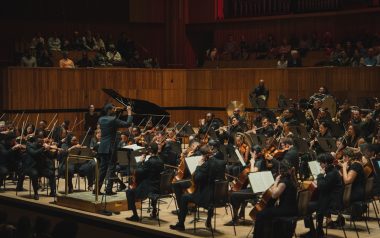 United Kingdom Watts, Saint-Saëns, Coleridge-Taylor: William Campbell (organ), Chineke! Orchestra / Leslie Suganandarajah (conductor). Royal Festival Hall, London, 2.2.2024. (CK)
United Kingdom Watts, Saint-Saëns, Coleridge-Taylor: William Campbell (organ), Chineke! Orchestra / Leslie Suganandarajah (conductor). Royal Festival Hall, London, 2.2.2024. (CK)

Tristen J.T. Watts – Overture in B-flat major, ‘Majestiqué’
Saint-Saëns – Symphony No.3 in C, ‘Organ’
Coleridge-Taylor – Symphony in A minor
For this concert Chineke! exchanged their usual home in the Queen Elizabeth Hall for the wider spaces of the Royal Festival Hall and drew a large crowd: they needed the organ for Saint-Saëns’s warhorse Third Symphony, but even without that it was a great pleasure to hear their orchestral sound in the larger hall.
In my ignorance I had assumed that the Organ Symphony would be the evening’s culmination: I was therefore surprised to see in the programme that the second half was to be devoted to Samuel Coleridge-Taylor’s Symphony in A minor, and – not knowing the work – I feared that it might make a rather pallid impression after the roar and glitter of the Saint-Saëns (I had enjoyed Coleridge-Taylor’s Othello Suite in an earlier Chineke! concert without finding it particularly distinctive). It was a sheer delight to discover how wrong I was.
I can only applaud the fact that Chineke! plays music for us that we would probably never otherwise hear; and that they give a platform to young composers as well as those who mainstream musical history has passed by. Tristen J.T. Watts is not yet twenty; yet he has his own YouTube channel and has apparently composed multiple large-scale works, classical and sacred, for a wide range of musical forces. We heard his Overture in B-flat major, ‘Majestiqué’: a bright and confidently written 14-minute piece for large orchestra (including six horns and two sets of timpani). A bold summons on the horns is followed by pizzicato strings providing the driving force while the woodwinds take turns with a solo spot. Rather too much of the strings in this role – and, later, doing much the same in a marcato 6/8 – though they did get a chance to play melody too. The music surges and subsides euphoniously; a sturdy tune appears; timpani octaves take over the motor role before a heartily English-sounding peroration.
Strange, though, to hear a contemporary piece, much of which might have been written around 1840 by Robert Schumann, perhaps, or Mendelssohn. Nothing really wrong with it, but nothing memorable either. Skilfully put together in an assembly-line sort of way; something, even, that might have been composed by AI.
The Saint-Saëns symphony was great fun: the first movement bowled along in its vigorous and expansively tuneful way, the playing well-defined and rhythmically alert, and the transition to the Adagio was beautifully done: the organ’s first notes felt rather than heard. There was rich mahogany tone from the lower strings; the string body as a whole racked up considerable intensity here and attacked the Scherzo with real bite. What a well-disciplined orchestra they are! William Campbell’s barnstorming organ entry was well prepared for, and the finale was everything it should be. Saint-Saëns could write a humdinger when he wanted to.

A word about the conductor, Leslie Suganandarajah. With extensive opera experience in Europe, he cannot be as young as he looks (another Esa-Pekka Salonen, perhaps?); his conducting style draws no attention to itself, yet he secures pinpoint playing of real expressivity. He seems able to find the music’s natural pulse and character without apparent exertion, and to communicate it to his players. His movements are never abrupt; he sways with the music with a natural elegance. I was incongruously reminded that the country of his birth produced the most prolific spin bowler Test cricket has ever seen.
Others will be familiar with Coleridge-Taylor’s symphony, written when he was only twenty; I was not, so I heard it with the pleasure of discovery. What comes across first is a sense of ease with his material and a genuine lyrical impulse: the opening is bold and rhythmically alive, the main theme genuinely ingratiating, with a gorgeous second theme on the cellos. Though the slow movement is apparently labelled ‘Lament’, it seemed to me full of Brahmsian warmth and sunshine, with a natural, unforced eloquence; a tiny violin solo at the end was like a single, turning leaf. We are into February at last, the music seemed to say: Spring is coming.
The Scherzo had the outdoor ‘lift’ that Dvořák’s does, with some tangy woodwind writing. There was nothing apprentice-like; everything sounded natural. The Trio was beautiful, very English – uplifting in the way Vaughan Williams can be. It was clear from the conductor’s body language how much he was enjoying it. Timpani and brass told us that the finale would be sterner stuff; yet nothing was forced, there was no striving for effect. A wide-ranging cello theme; a lovely, free melody on the horn; a delightful, lilting tune on bubbling clarinets and flutes; a beautiful winding down to the end. If he could write like this when he was barely out of his teens, what symphonies would he have gone on to compose?
The fact that I have referenced three great composers of symphonies may suggest that the work is derivative, a shadow of greater things. I can only say that it did not sound that way; and the fact that Coleridge-Taylor’s musical personality is gentle, not at all exotic, does not mean that it is not distinctive. Using the same forces as Brahms’s Second and Dvořák’s Eighth, he has written a symphony that does not challenge them – of course it doesn’t – but which we can enjoy in the same way that we do those masterworks. Thank you, Chineke!
Chris Kettle
